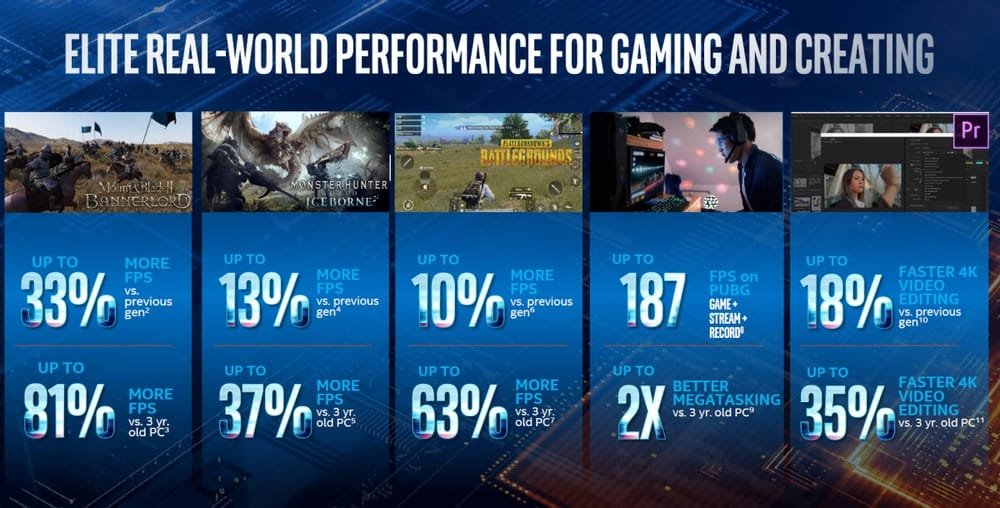Here’s a look at the best RAM for Intel 10th Gen ‘Comet Lake’ CPUs (i3/i5/i7/ i9) to help you decide which sticks will work best with your new PC.
The “best ram for intel i9 10th gen” is a question that has been asked multiple times. The answer to this question is that the best RAM for Intel 10th Gen ‘Comet Lake’ CPUs (i3/i5/i7/i9) is DDR4-3000.
Intel’s 10th-generation ‘Comet Lake’ processor
Intel has unveiled Comet Lake S, the tenth generation of its desktop CPUs, as predicted. The CPU maker hopes to gain ground on AMD’s Ryzen 3000 with this.
Intel is following suit at the desktop level over nine months after introducing the Comet Lake series for mobile CPUs. The new Core i-10000 series desktop CPUs, also known as Comet Lake S, are designed to compete with AMD’s Ryzen 3000. The new top model, the Core i0-10900K, is designed to outperform the previous top model, the Core i9-9900K, by up to 30%.
The top CPU, the Intel Core i9-10900K is a high-end processor., is expected to be 30% quicker than its predecessor.
The Core i9-10900K has ten computational cores and consequently 20 threads, as predicted. Structure widths of 14 nanometers are still used in production. Intel, on the other hand, wants to optimize the process so that clock speeds may be increased even further. Intel rates the 10900K at up to 5.3 gigahertz and 125 watts of power dissipation.
However, only the so-called Thermal Velocity Boost, which Intel already utilizes in mobile CPUs for laptops, can attain optimum performance. The CPUs can only run at their greatest clock rate for a limited period of time before the chips overheat owing to the required voltage. The fundamental clock frequency is 3.7 gigahertz.
| Processor | Cores/Threads | Clock at the Start | Turbo on a single or all cores | TDP | Cost |
|---|---|---|---|---|---|
| Core i9-10900K | 10/20 | 3.7GHz | 5.3GHz/4.9GHz | 125W | $488 |
| Core i9-10900 | 10/20 | 2.8GHz | 5.2GHz/4.6GHz | 65W | $439 |
| Intel Core i7-10700K processor | 8/16 | 3.8GHz | 5.1GHz/4.7GHz | 125W | $374 |
| Core i7-10700 | 8/16 | 2.9GHz | 4.8GHz/4.6GHz | 65W | $323 |
| Intel Intel Core i5-10600K processor | 6/12 | 4.1GHz | 4.8GHz/4.5GHz | 125W | $262 |
| Core i5-10600 | 6/12 | 3.3GHz | 4.8GHz/4.4GHz | 65W | $213 |
| Intel Core i5-10500 | 6/12 | 3.1GHz | 4.5GHz/4.2GHz | 65W | $192 |
| Intel Core i5-10400 | 6/12 | 2.9GHz | 4.3GHz/4.0GHz | 65W | $182 |
| Intel Core i3-10320 | 4/8 | 3.8GHz | 4.6GHz/4.4GHz | 65W | $154 |
| Intel Core i3-10300 | 4/8 | 3.7GHz | 4.4GHz/4.2GHz | 65W | $143 |
| Intel Core i3-10100 | 4/8 | 3.6GHz | 4.3GHz/4.1GHz | 65W | $122 |
All Intel ‘Comet Lake’ processors from the 10th generation
According to Intel, the i9-10900K is the world’s fastest gaming CPU.
The Core i9-10900K is billed as the “fastest gaming CPU in the world,” according to Intel. Intel provides customizable overclocking for each particular processing core in order to better optimize performance for this specific application.
In a comparison image, Intel demonstrates the impacts as well as the improved performance over the previous edition. The 19 percent better performance in video editing is sure to pique the curiosity of editors. Intel even guarantees a performance boost of up to 35 percent if you have a three-year-old PC.
The Core i-10000 is compatible with LGA1200 and Thunderbolt 3 motherboards in the 400 series.
All of the new CPUs contain the Intel 400 chipset, which is Thunderbolt 3 ready and supports the latest Wi-Fi 6 standard (Gig Plus). In terms of Socket for CPUing, Intel is moving to LGA1200. It is not compatible with the Core i-9000 processor.
The Core i7 has eight cores, the Core i5 has six, and the Core i3 has four cores, all below the current i9’s 10 cores. In terms of graphics, Intel has stuck with the UHD 630. DDR4-2933 memory is supported by the i9 and i7 processors, whereas DDR4-2666 memory is supported by the i5 and i3.
Hyperthreading is also available for Intel’s 10th generation i3, i5, and i7 processors.
The reintroduction of hyperthreading is the most intriguing improvement for purchasers of all classes below i9. Processors may now process two threads per core instead of only one. Only the i9 had this technology in the previous iteration; with Comet Lake S, all CPUs beginning with the i3 have it.
The new processors have wholesale costs ranging from 400 to 500 dollars for the i9, 160 to 370 dollars for the i5, and 120 to 150 dollars for the i3 series. When the CPUs will be released, Intel has not said. Until now, it was thought that availability would begin in the second week of May.
What factors should you consider while purchasing RAM modules?
Regardless of the kind of memory you’re purchasing, you should examine the answers to the following questions, which are often addressed in the manual or on the manufacturer’s website:
- On the motherboard, how many (available) slots are there?
- Are the slots DDR3 or DDR4?
- Is the CPU cooler so close to the slots that it restricts the height of the RAM modules?
- What is the maximum amount of memory (total/per module) that may be used in GiByte?
- What clock frequency has the CPU and mainboard been built for?
- Is there anything more that has to be considered, such as the internal structure (memory rankings per module)?
- Overclockers take note: Is it possible to overclock the RAM with these components?
Aside from the hardware, the operating system also sets a restriction on the amount of RAM that may be used. Windows 7 Home Premium, for example, only supports up to 16 GB of memory, but Windows 8 and 10 support at least 128 GB of memory (in the 64-bit version). ECC is supported by AMD’s FX series and Ryzen processors, however “unbuffered,” “unregistered” RAM without ECC is adequate in desktop PCs. The words “completely buffered,” “registered,” and “ECC” refer to approaches that are used to protect the data integrity of servers with a lot of memory.
For the purpose of simplicity, you may purchase the presently installed memory if you have open slots and wish to increase the quantity of RAM. You may pick modules with comparable qualities if identical memory is no longer available (at a fair price) (clock rate, capacity, voltage, timings, ranks). Lists of suitable memory modules can generally be found in the motherboard’s manual or on its support page.
How much memory do I require?
The capacity of RAM is the most significant attribute since it has the greatest impact on the overall performance of the system. Because the RAM is completely occupied and cannot keep all of the essential data if the quantity of memory is insufficient, material is often requested from the SSD or HDD. You will notice these waiting periods while using the PC since these storage media are substantially slower than RAM in terms of transfer rate and access time. You may get over it with basic chores like perusing the Internet, but with PC gaming, you rapidly approach the limit of what is tolerable.
For PC gaming, 16 Gigabytes of RAM is adequate.
There isn’t a lot of RAM. However, you may improve system performance by investing not only in as much RAM as possible, but in the capacity that is truly required and RAM modules with higher performance values (clock/timings).
We recently researched whether performance variations emerge from utilizing 4, 8, 16, and 32 GiByte RAM in Assassin’s Creed Odyssey, Kingdom Come: Deliverance, and Quake Champions (with graphical modifications) in many test series.
4 Gigabytes proved out to be inadequate, even for low-cost PCs. All games were playable with 8 GiByte, although players should be aware of the following limitations: In certain games, half the memory capacity causes more micro jerks as compared to 16 GiByte. In these circumstances, frame timings climb to 20 to 25 milliseconds, but frame times with 16 GiByte have a maximum delay of 15 milliseconds. Because the higher swings with 8 GiByte disrupt the game’s rhythm, we concur with the advice made by developers more frequently: With 16 GiByte, you’re in good shape in today’s games. In certain situations, such as Ark Park, the minimal system need is already 16 GiBytes, however 32 GiBytes may be more future-proof.
Is it worth it to have a working memory of 32 GiBytes or more?
In compared to 16 GiByte, 32 GiByte has provided minimal benefits for PC gaming thus far. Even with this amount of RAM, some jerking might happen from time to time. However, this is often due to engine quirks rather than a shortage of memory. Even with a lot of RAM, open-world games, in particular, demand a little reload break now and again. 32 GiByte are appealing to gamers with a higher budget, who prefer to multitask, and who are prepared for any situation. This quantity of RAM is not yet worth it if the price-performance ratio is really essential to you. 32 GiByte is still recommended for upgraders with a medium to long-term perspective, notwithstanding the lower pricing. The RAM requirements of games may climb dramatically again with the following console generation.
If you utilize image processing, virtual machines, and/or RAM drives often, you may want more memory than 16 or 32 GB. Manufacturer advice, other users’ experiences, and your own observations may all be helpful in this instance. Photoshop by default saves roughly 70% of available RAM and, in the best-case scenario, produces a 100% efficiency result. Lower levels suggest that the SSD/HDD is being used, and additional RAM may assist.
For Intel 10th Gen CPUs, how essential is RAM clocking speed?
One of the most critical components of a computer is RAM. What role do time and latencies play in this? Memory with relatively rapid clock rates of up to 2933 MHz ex works is now supported by current AMD and Intel CPUs. Furthermore, higher clock speeds are no longer exceptional; in these instances, the employment of a customized profile allows for proper RAM management. However, you must change a setting in the BIOS to acquire these clock speeds.
| CPU socket | Type of processor | RAM clocks that are supported |
|---|---|---|
| 1200 Intel | Intel Core i5 / i7 / i9 10th Generation | 3200 MHz |
| 1151 v2 Intel | Core i5 / i7-8000, Core i5 / i7 / i9-9000, Core i5 / i7 / i9-9000 | 2666 MHz |
| 1151 v2 Intel | Celeron G, Pentium Gold, Core i3-8000, Core i3-9000 | 2400 MHz |
| 1151 Intel | Pentium G, Pentium Gold, Core i3 / i5 / i7-7000, Core i3 / i5 / i7-7000 | 2400 MHz |
| 1151 Intel | Pentium G, Celeron G, Core i3 / i5 / i7-6000, Core i3 / i5 / i7-6000 | 2133 MHz |
| 2066 Intel | Core i5 / i7 / i9-7000, Core i7 / i9-9000, Core i7 / i9-9000 | 2666 MHz |
| 2066 Intel | Intel Core i7-7000 | 2400 MHz |
| AMD AM4 | The Ryzen X 3000 is a high-end processor. | 3200 MHz |
| AMD AM4 | 3/5/7 2000 Ryzen | 2933 MHz |
| AMD AM4 | Athlon 3/5/7 1000, Ryzen 3/5/7 1000 | 2666 MHz |
| AMD AM4 | Athlon XP, Athlon XP, Athlon XP, A | 2400 MHz |
| AMD TR4 | Threadripper Threadripper Threadripper Threadripper Threadripper Threadripper Thread | 2933 MHz |
| AMD TR4 | Threadripper 1000 Ryzen Threadripper 1000 Ryzen Threadripper 1000 Ryzen Thread | 2666 MHz |
The maximum RAM clock on several available mainboards is substantially greater than the above-mentioned figures. Using the so-called XMP protocol is the simplest approach to increase the RAM’s clock speed (Extreme Memory Profile). In this profile, RAM bars and mainboard manufacturers specify higher maximum RAM clock rates. A rise in supply voltage is often associated with this. Even though the makers do comprehensive testing for this, there is no 100% assurance of compatibility and stability. This implies that activating such a profile is not suggested if you want to use a computer 24 hours a day, seven days a week.
Please note how many memory channels the motherboard you’re using supports in order to have the best data throughput. This value represents the maximum number of memory locks that the processor or memory controller may access simultaneously. A dual-channel design is used on the majority of mainboards. When compared to a single memory bar, two RAM modules provide a substantial speed improvement.
What does RAM timing entail?
Number sequences such as “8-8-8-24” or “CL8 8-8-24” may be found in RAM. The numbers represent timings, which are listed in the following order: CL, tRCD, tRP, and tRAS.
- CL stands for CAS Latency and refers to the time between the processor’s data request and the working memory’s commencement of data delivery.
- RAS to CAS delay is abbreviated as tRCD. This is the time between the line’s addressing and the subordinate column’s addressing.
- RAS precharge is abbreviated as tRP. The time between deactivating a row and picking a new row is measured in seconds.
- Active to precharge Delay is abbreviated as tRAS. This is the amount of time that must pass between a successful access and the following access.
What effect do low latencies have on Intel’s 10th Gen ‘Comet Lake’ CPU performance?
In theory, greater clock rates are desirable to decrease latency. If the RAM’s maximum configurable clock rate has already been reached, a reduced latency might provide a tiny performance boost. This is important just if you want to get the most out of your computer. Working memory with short latencies offers a substantially bigger performance increase when utilizing an APU. A delay of 14 to 16 is suggested in our scenario with the 2993 MHz fast DDR4 modules.
Find out what the clock rates are and how to modify them in the bios.
It is simple to determine the current RAM clock using a current version of Windows 10. Switch to the Performance tab in the Task Manager. The speed is simple to read with the window maximized and memory chosen. You can also check how many RAM modules are installed and how many slots are accessible. You can tell if the RAM is Dual Channel or not by looking at this.
If you wish to speed up the RAM clock rate, you may do it easily via the BIOS. To do so, just enable the appropriate memory profile. To do so, turn on your computer and enter the BIOS by pressing the “F2” or “Del” keys during startup. The XMP, which can be located under the Overclocking Settings, is activated there. It’s also conceivable that the RAM comes with many profiles; in this case, you’ll have an option. Restart the computer once you’ve confirmed the changes you’ve made. You may then verify whether the configured clock is still present in Task Manager.
Budget Intel 10th Gen i3 Builds with the Best RAM
Best RAM for Workstation Builds with Intel 10th Gen i7 & i9 Processors

The Vengeance RGB Pro Kit impresses with effective RGB lighting, solid basic performance, and a substantial reserve that tuners may unleash thanks to Samsung and Micron processors. In a straight comparison, the 2018 version is undoubtedly superior, but it also cost 480 dollars at the time of debut. Meanwhile, the kit is offered for $170, a 60 percent discount, and is an excellent RAM module for Intel’s 10th Generation ‘Comet Lake’ CPU family.
In reality, the Corsair kit is one of the most affordable variants on the market with this capacity and a DDR4-3200 (or higher) release, as well as RGB LED illumination. In this regard, Corsair’s CMW32GX4M4C3200C18 kit will also be unavailable in 2021, however it is a fairly priced kit with few flaws. Finally, keep in mind that our testing may only give a limited view into the industry, and we cannot cover all available kits. It’s likely that dealers still have copies of the CMW32GX4M4C3200C18 kit in store with Samsung B dies, and that other components than the Micron D9TBH are being used. In any event (as with other DDR4 RAM kits), modest to bigger variations from the tuning results we attained may be anticipated, depending on CPU, motherboard, ability, and luck. Perfect with Intel’s 10th Generation ‘Comet Lake’ CPUs. Ideal for Intel Core i9-10900, i7-10700, and even i5-10500 processors from the 10th generation.
The Best RAM for Intel 10th Generation Gaming PCs
We picked two RAM variants for the Gaming setup with a 10th Gen Intel CPU. One with RGB illumination if you have a gaming computer with a glass casing, and one non-RGB RAM module for those who aren’t concerned with appearances.
Vengeance LPX from Corsair

The Vengeance LPX, the first product in our RAM comparison, is a Corsair product that comes in a pair of two RAM bars. This module is in the upper mid-range in terms of price, which is why it is targeted at more demanding consumers. There are two RAM bars here, each having an 8 GB memory capacity and a 3,000 megahertz clock frequency.
The Intel X99, 100, and 200 series motherboards are supported by the Vengeance LPX. Overclocking is automatic and trouble-free thanks to XMP 2.0 support. The Vengeance LPX series modules are made up of an eight-layer PCB and memory ICs that have been thoroughly tested. This model’s SPD latency is 15-15-15-36.
The manufacturer recommends a maximum working temperature of 85 degrees Celsius. The heat spreader’s unique architecture transfers heat from the ICs into the system’s cooling channel properly, enabling it to be utilized even more intensively. Low power consumption and maximum compatibility have also been evaluated for this memory. The weight is slightly under 5 oz. and the measurements are 6.10 x 3.54 x 0.39 inches. Because of the flat form, installation is a breeze. Overall, this RAM module is ideal for gaming setups using an Intel 10th Generation ‘Comet Lake’ CPU. Ideal for Intel Core i9-10900, i7-10700, and i5-10500 processors from the 10th generation.
Vengeance RGB Pro by Corsair

The freestanding, milky plastic strip at the top edge of the Corsair Vengeance RGB Pro is the first thing you notice. Ten RGB LEDs are hidden underneath this, providing stylish lighting effects while in use. The lighting is still entirely enclosed by the cooling fins on the Corsair Vengeance sans the Pro brand prefix, and so is slightly more veiled. Great for Intel’s 10th Generation “Comet Lake” CPU setups.
The white heat sink starts below the lighting strip and is perforated in the top portion, enabling the illumination to show through in certain areas. A black sticker with the product name is placed in the centre, providing some contrast with the black PCB.
While Adata was able to lower the total height of the Spectrix D41 thanks to the new design, the Corsair Vengeance RGB Pro is much bigger, measuring roughly 51 mm. Those who use a traditional air cooler for the CPU should check to see whether the RAM and cooler are compatible.
When the PC is turned on, the RGB LEDs turn on right away, and the color and lighting effect may be adjusted using the Corsair iCUE program. It is now possible to synchronize the lighting of various Corsair components with the latest version.
MSI Mystic Light and Gigabyte RGB Fusion are also compatible with the Corsair Vengeance Pro RGB. Our test kit comprises of two eight-gigabyte modules with a clock frequency of 3,600 megahertz with CL 16-18-18-36 timings.
The Corsair Vengeance RGB Pro performs well on our benchmark course because to its high clock frequency of 3,600 MHz. It compares well to Adata’s XPG Spectrix D41 and, depending on the test, either slightly ahead or slightly behind its opponent. Both rivals don’t pay much attention to each other in the gaming benchmark, with the Adata Kit slightly ahead. This shouldn’t be evident in reality, particularly as the minimum frame rates vary by just one frame per second.
With its RGB lights, the Corsair Vengeance RGB Pro is quick, reliable, and enriches the inner workings of any PC. Lighting can now be coordinated with other Corsair RGB devices thanks to the new iCUE software. Overall, this RGB RAM solution is ideal for all Intel 10th Generation ‘Comet Lake’ CPU configurations. Ideal for Intel Core i9-10900, i7-10700, and i5-10500 processors from the 10th generation.
Budget Intel 10th Gen i3 & i5 Builds with the Best RAM

We suggest the HyperX Predator 8GB RAM stick for budget setups using an Intel 10th Gen i3-10100, i3-10300, i3-10320 or i5-10400, i5-10500, i5-10600 processor. In this comparison, the HyperX Predator 8GB RAM is quite comparable to its predecessor and is similarly in the high midrange in terms of pricing. There are 8 gigabytes of RAM included, as well as one RAM bar with a clock rate of 3000 megahertz. According to the manufacturer, the operating temperature should not exceed 85 degrees Celsius. The needed voltage is 1.5 volts, and the CAS delay is CL10.
The Fury’s asymmetrically built heat sink adds that little something aesthetically. With the HyperX Fury, both AMD and Intel gamers receive their money’s worth, particularly for budget setups with Intel 10th Gen CPUs. Kingston has also tested this model on all relevant mainboards from a variety of vendors. As a result, you can be rather certain that the RAM will work well with a variety of brands. The product weighs 1.8 ounces and is 0.32 x 1.66 x 5.25 inches in size.
The “best ram for intel i7-10700k” is a question that has been asked by many. The answer to this question will be given in the form of an article.
{“@context”:”https://schema.org”,”@type”:”FAQPage”,”mainEntity”:[{“@type”:”Question”,”name”:”What RAM is best for Intel 10th Gen?”,”acceptedAnswer”:{“@type”:”Answer”,”text”:”A: Most people find that 8GB is enough for their needs. However, if youre a video editing professional or someone who uses RAM intensive programs such as Adobe Premier Pro, then 16gb should be adequate.”}},{“@type”:”Question”,”name”:”Which RAM is best for i3 10th Gen?”,”acceptedAnswer”:{“@type”:”Answer”,”text”:”A: At this time, RAM is not recommended for the i3 10th Gen. But if you are looking to upgrade your current RAM in order to improve performance, then at this time G.Skill Ripjaws 4 16GB Kit (2x8GB) PC4-21300 DIMM would be a great option”}},{“@type”:”Question”,”name”:”What RAM does i7 10th Gen support?”,”acceptedAnswer”:{“@type”:”Answer”,”text”:”A: This is a tough question. I do not have that information at my disposal, but you can go to https://www.cyberpowerpc.com/en-us/systems/intel-cesa1020i7 and see if it says anything about RAM on there”}}]}
Frequently Asked Questions
What RAM is best for Intel 10th Gen?
A: Most people find that 8GB is enough for their needs. However, if youre a video editing professional or someone who uses RAM intensive programs such as Adobe Premier Pro, then 16gb should be adequate.
Which RAM is best for i3 10th Gen?
A: At this time, RAM is not recommended for the i3 10th Gen. But if you are looking to upgrade your current RAM in order to improve performance, then at this time G.Skill Ripjaws 4 16GB Kit (2x8GB) PC4-21300 DIMM would be a great option
What RAM does i7 10th Gen support?
A: This is a tough question. I do not have that information at my disposal, but you can go to https://www.cyberpowerpc.com/en-us/systems/intel-cesa1020i7 and see if it says anything about RAM on there
Related Tags
- best ram for i9 10900k z590
- best ram for intel 10th gen reddit
- how much ram can i5 10th gen processor support
- i7 10th gen ram support
- i7-10700k ram support




